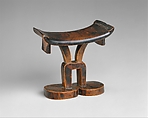Headrest
Not on view
Carved wooden headrests have a long history in Africa. This Tsonga headrest from southern Africa represents a specific stylistic interpretation of the form that Tsonga carvers have developed. Headrests were made to sleep on while at the same time protecting the elaborate coiffure of the sleeper. Headrests are small, their height being the average distance from ear to shoulder. The origins of this tradition are unknown, but the oldest extant examples date back to ancient Egypt.
This headrest, like most others, consists of three basic elements: two horizontal planes joined by a vertical post. Tsonga artists have invested a great deal of creative ingenuity in designing the composition and structure of the supporting vertical post. This headrest's support is composed of a V-shaped bracket resting on a downward U-shaped form. The horizontal plane on top takes a slightly concaved, rectangular form and features incised geometric patterns along the surface edges. Included on the underside of the upper ledge are small pendant pieces known as ears or lugs. Lugs can take a number of different forms; in this case, they are square tabs positioned parallel to the main axis of the headrest. Nearly all Tsonga headrests have lugs, but not all headrests that have lugs are necessarily Tsonga. The base of this headrest is formed from two conjoined circular forms.
The symbolism of the form and composition of Tsonga headrests remains a point of debate. One interpretation draws upon a popular theory regarding the headrests of the nearby Shona peoples. Among the Shona, headrests are believed to be metaphors for women. There are clues for interpreting some Tsonga forms as female, for example, it has been suggested that the lugs of Tsonga headrests can be decorated with beaded earrings like a young girl. In Tsonga society, however, headrests are not limited to male-only use as they are in Shona society. So it seems unlikely that women slept on "female" headrests, either metaphorical or representational. Meaning may not necessarily lie with the formal appearance and structure of the headrest, but in its use and history. A headrest that has been owned and used by a particular ancestor has a value beyond anything indicated by its physical appearance. In other cases, as the headrest was consistently used and handled, it would become personalized to such a degree that upon the owner's death, he would be buried along with the headrest and other personal items. Headrests have also been described as mhamba, a Tsonga term used to describe any object, act, or even person that is used to establish a bond between the gods and people. For example, the headrest is conceived to serve as a communicating vehicle through which to contact ancestors and spirits in dreams.
This image cannot be enlarged, viewed at full screen, or downloaded.

